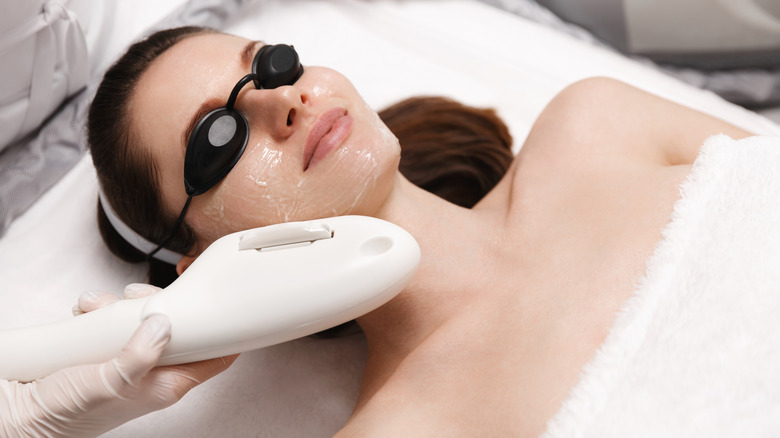IPL Photofacials Could Be The Solution For Textured, Sun-Damaged Skin
When it comes to mental health, sun exposure is an essential tool: Spending time in the sun can boost serotonin, which makes you feel good, per Verywell Mind. In addition, it can lessen the chances of developing depression or seasonal affective disorder (SAD). However, the sun's benefits go beyond your state of mind — they can also physically affect you. For example, the sun assists the body in producing vitamin D, which reduces the chances of developing bone diseases such as osteoporosis, according to Healthline. But the sun can also be your skin's worst enemy, as the Cleveland Clinic describes: Referred to as photoaging, too much sun can lead you to age quickly.
Photoaging can permanently damage the skin and form wrinkles, liver spots, and discoloration, amongst other things. Unfortunately, photoaging can also cause skin cancer, such as melanoma, and conditions like rosacea. So how can you protect your skin from sun damage? Experts recommend wearing sunscreen every day by incorporating it into your skincare routine. To recover from a weekend in the sun, wear a hat, moisturize, and apply sunscreen. If you have long-term sun damage, there's another solution; you could opt for an IPL photofacial. This state-of-the-art technology promises to reduce the signs of photoaging and more.
IPL photofacials use light therapy
Although it has the word "facial" in it, IPL photofacials can be best described as a form of treatment. According to WebMD, IPL (which stands for intense pulsed light) photofacials involve light therapy to target photoaging. Moreover, it can treat more than just the face; it can be used on different parts of the body, including the neck, legs, and more. IPL photofacials work by applying heat to the skin that is sun damaged via a laser. As described by Ideal Image, this heat encourages the skin to produce collagen, which in turn, leads your skin to heal and look better than it did before.
It also breaks down the melanin caused by sun damage to decrease the signs of photoaging. Beyond this, IPL photofacials can banish scars, acne, birthmarks, and even hair. If you want to reduce more than just the signs of sun damage, you can customize IPL photofacials to do so. In a TikTok, user @thecadibrand recorded herself while undergoing an IPL photofacial and noted that she loves the results of the treatment. She said, "I've noticed that since I've been getting them, my skin is firmer and tighter."
Unfortunately, an IPL photofacial is not ideal for everyone; the treatment works best on individuals with a fair to medium complexion, per WebMD. If you are unsure whether an IPL photofacial is for you, talk to your doctor first.
How to prep for an IPL photofacial
In the weeks before your treatment, your doctor will lay out some rules for you, including cutting back on your sun exposure. You also won't be able to use a tanning bed, or get waxed to prep for an IPL photofacial. In addition, your doctor will discuss with you what medications you take to ensure that none will interfere with the IPL photofacial. As for the price, on average the treatment costs a few hundred dollars and a session can take less than an hour, although the number of sessions needed will vary from person to person. Lastly, keep in mind that receiving an IPL photofacial may cause discomfort.
However, in a video by TikTok user @jenmarie.90, she described the pain as "minimal." If you're sensitive to pain, ask your doctor to apply numbing cream. The recovery process is simple: You can expect redness and sensitivity, and the appearance and texture of your skin might change a few days after the treatment.
In a TikTok, user @jjs.gems showed how her face looked in the moments and days after her IPL photofacial. At first, her face appears blotchy and tight, but after 10 days, her skin is radiant. If you received an IPL photofacial, wear sunscreen and abide by any directions given by your doctor to ensure you get the best results from your treatment.
